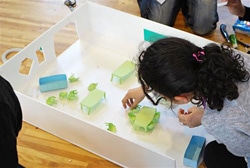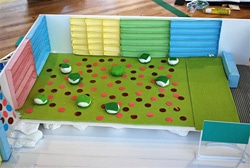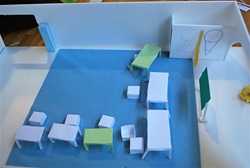



[IWATE, JAPAN, 14 November 2012]
 |
| Fifth graders enjoy creating a model "Future Classroom" during the workshop. |
A special workshop was launched in late October at primary schools in Otsuchi Town, Iwate Prefecture. The workshop provides children with the chance to build plastic models of classrooms and school facilities from their own perspective, allowing them the chance to communicate their ideal environment for studying, reading and playing. The third installment of the workshop was held on 14 November, where the children's models were completed.
Otsuchi Town was heavily damaged in the 11 March 2011 Great East Japan Earthquake. As part of its reconstruction plan, the town has launched various children-oriented activities. As part of its reconstruction assistance for the affected areas, the Japan Committee for UNICEF (JCU) implements the Children's Reconstruction and Urban Development Programme. One example is a project being conducted under the town's reconstruction plan to construct an integrated primary and junior high school. JCU has provided assistance within this project framework to ensure that children's ideas and opinions are incorporated into the construction process.
 |
| One group created this library room. Half is covered in artificial grass and decorated with cushions. There is a special storage area beneath the grass. |
This workshop is part of a collaborative project between Professor Shinya Sato—a specialist in urban planning, urban development education and natural disaster studies at the Yamagata University Faculty of Education, Art and Science—and the Takenaka Corporation, which proposed the concept of "urban development with children for reconstruction" and serves as the cornerstone for the project.
Approximately 90 fifth graders from four primary schools in Otsuchi, Otsuchi-Kita, Ando and Akahama gathered to participate in the workshop. The children from the four schools currently study together at a temporary school building and will be integrated into Otsuchi Primary School from next April. Under the leadership of Takenaka Corporation staff, Professor Sato and students from his faculty separated into 18 groups to discuss ideas and enjoy building models with the children.
The children's models exhibited diverse creativity: some buildings were round with four rooms (library, kitchen, etc.) and had rotating classrooms and some had windows over the blackboards so that students could enjoy a view of the outdoors during class. A boy from a group that had designed a library that was half-covered in artificial grass and decorated with comfortable cushions explained that, "Students can comfortably rest on these cushions as they relax and enjoy reading books."
 |
| A classroom with a bathroom located at the corner. This model reflects the students' experience living at shelters. |
Each model was rich with the type of free imagination that only children can offer. Some even presented ideas drawn from the children's experiences living at shelters, temporary housing and attending schools at temporary school facilities. Fifth grade teacher Mr. Ashizawa, who was in charge of overseeing this special workshop, voiced that, "This class goes beyond simply having fun. I was impressed by the fact that the children actually considered disaster prevention measures and proposed some very creative solutions." Some products had kitchens and bathrooms at the corners of classrooms and gymnasiums, and special storage space for emergency reserves, reflecting the children's experience staying at shelters. Mr. Ashisawa noted that, "If you look at the large furniture fixed firmly against the wall and the choice of solid, sturdy chairs, you can tell the students want a safe classroom that can withstand an earthquake."
Professor Sato, from Yamagata University, also commented on the children's creativity, saying, "Only the children of Otsuchi Town could have been capable of these results. I really felt their ability to resolve difficulty. It would be great if that these activities were communicated to children all over Japan."
Assistant Director to the Counselor Watabe of the Iwate Prefecture Reconstruction Bureau, Reconstruction Agency, was present to observe the workshop. Mr. Watabe expressed his interest in the activities: "I hope that a form of urban development is undertaken that incorporates the opinions of the children. It would be great if this type of disaster-preparedness effort were spread to other municipalities in Japan."
At the end of the workshop, a student representative thanked everyone that had made the workshop possible and expressed the students' eagerness to continue the activities: "We hope to share these models with the rest of the school and use them during the lesson planned for the third academic quarter, which is aimed at considering the future of Otsuchi Town." The Japan Committee for UNICEF expects that the unwavering hope of Otsuchi children will to lead to the actual establishment of new classrooms, school facilities and a fresh approach of urban development. JCU will continue to exert every effort to supporting this programme.
All photo credits: © Japan Committee for UNICEF